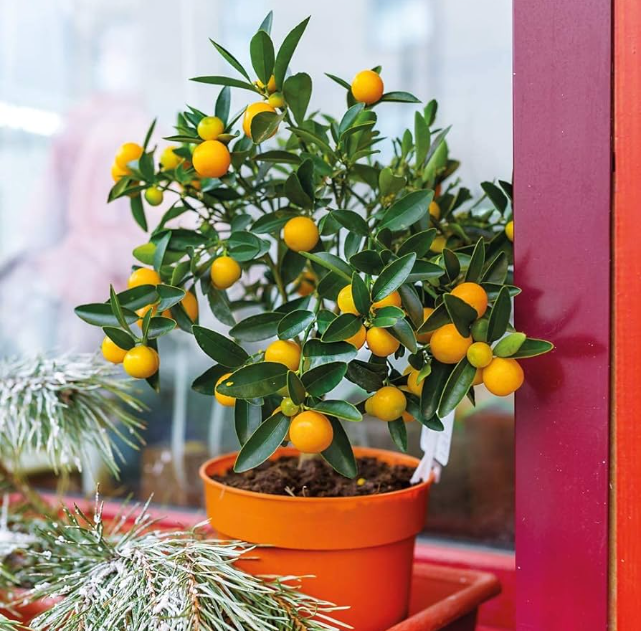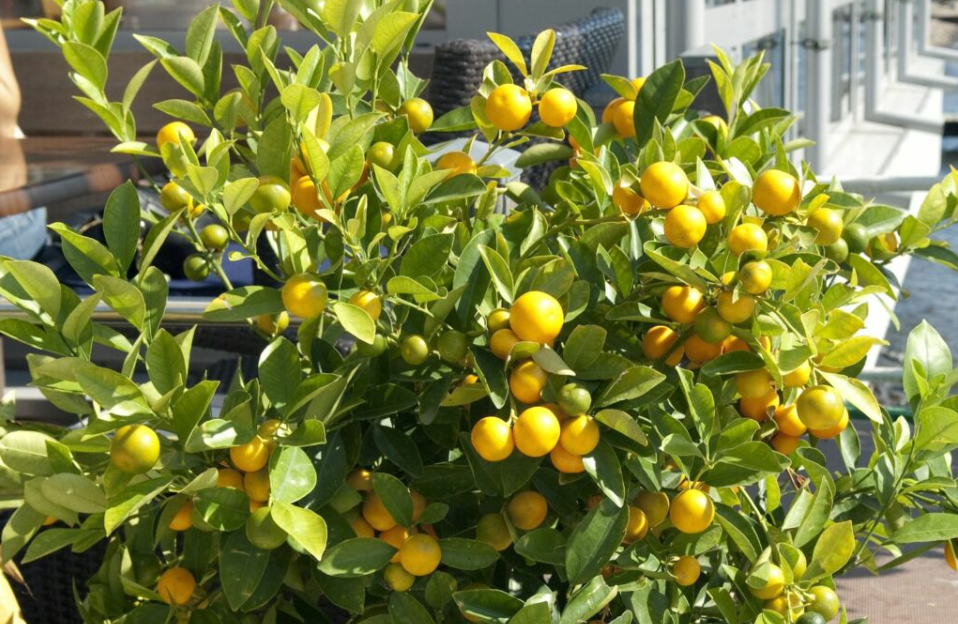
The Calamondin orange tree, also known as calamansi or by the botanically obsolete terms Citrus mitis and Citrus x madurensis, is a natural hybrid, probably originating in China, between the mandarin orange (Citrus reticulata) and a species of kumquat (Fortunella margarita). It is native to the Philippines, parts of Indonesia (Borneo, Sumatra, and Sulawesi), Malaysia, and Brunei, as well as parts of southern China and Taiwan.
The Calamondin orange tree is characterized by its small, round fruits that resemble a small lime, usually 25–35 mm (1–1 3⁄8 in) in diameter, but sometimes up to 45 mm (1 3⁄4 in). The trees are small, rising to a maximum of 10 to 20 feet. They are evergreen, and their spreading crowns are crowded with 4-inch leaves.
Spring fills the calamondin tree with fragrant blossoms, each comprising five, snowy white petals with a delightful fragrance. Flowers continue to arrive in smaller amounts throughout the year. It is widely cultivated in Southeast Asia. This plant is also commonly referred to as the Philippine lime.
The tree is a popular ornamental plant in the United States, especially in Florida and Hawaii. It is sensitive to prolonged and/or extreme cold and is therefore limited outdoors to tropical, sub-tropical and the warmer parts of warm temperate climates, such as the coastal plain of the southeastern United States (USDA zones 8b – 11), parts of California, southern Arizona, southern Texas, and Hawaii.
Patience is required if you plant calamondins, since the fruits hang on the tree for months before they are ripe. It is not unusual for calamondins to take a full year to ripen. This makes the tree a highly attractive ornamental but is tough on those awaiting ripe fruit. When you see the fruit begin to turn orange, you will know the end is in sight. But don’t wait until the fruit is soft or fully orange to pick it. Select firm fruit that is beginning to turn from yellow to orange.
Characteristics
- Habit: The calamondin has a bushy and compact growth habit. It grows as a multi-stemmed shrub rather than a single-trunked tree.
- Size: Calamondin orange trees are relatively small, reaching heights of 3-6 feet (1-1.8 meters). They can be grown in containers or as a small shrub in the garden.
- Growth Rate: This citrus gem is a slow to moderate grower, adding 6-12 inches per year. In ideal conditions, it might reach up to 18 inches annually.
- Leaves: The leaves are small, glossy, and evergreen, adding to the aesthetic appeal of the tree.
- Flowers: The trees produce fragrant, white flowers that bloom in the spring.
- Fruits: The tree bears small, round fruits that resemble miniature oranges, which are about 1 inch (2.5 cm) in diameter. The fruits are a bright orange color when ripe. The fruit appears on the tree at the same time as the flowers in springtime. Unlike regular oranges, the rind is thin and edible, with a slightly sweet flavor.
- Bark: The bark of the tree is typically smooth and light brown in color.
- Root System: The tree has a shallow root system that spreads out horizontally.
- USDA Zones: The tree is hardy in USDA plant hardiness zones 8b – 11, one of the hardiest citrus varieties.
- Lifespan: With proper care, this tree can grace your home or garden for 20 to 50 years, offering years of enjoyment.
- Fruiting Time: It can start bearing fruit as early as 2-3 years old, with fruiting often occurring throughout the year in warm climates.
Cultivation

- Pot the tree in a large container filled with a mixture of 1 part each potting soil, organic compost and per-lite or vermiculite. Give the tree plenty of room to spread out and establish a healthy root system. Replant container plants every few years to prevent roots from becoming root bound.
- Provide direct sunlight for at least several hours daily. Move the plants outdoors for a few hours daily in the spring, increasing the time outdoors until the tree can stay outdoors for the summer. Bring the tree indoors in the fall, before the first cold snap. Decrease the time outdoors slowly until the tree is acclimated to staying indoors.
- Water your calamondin orange tree regularly, but be careful not to overwater it. The soil should be moist but not soggy. Allow the top inch of soil to dry before watering again.
- Fertilize your calamondin orange with a citrus formula or a slow-release formula specifically for acid loving plants during the growing season. Dilute the fertilizer to half the recommended strength during the winter months.
- These trees are relatively resistant to pests and diseases. However, they can be susceptible to scale, aphids, and mealybugs. Inspect the foliage regularly and before bringing the tree in for the fall. Treat insect infestations chemically, following the directions on the package.
- Prune your calamondin orange tree only as needed to remove dead or diseased branches. Pinch back water sprouts or spurs that grow from the trunk or roots.